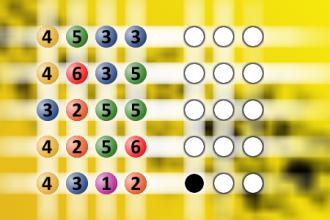What a winning combination?
The computer chose a secret code (sequence of 4 digits from 1 to 6). Your goal is to find that code. Black circles indicate the number of hits on the right spot. White circles indicate the number of hits on the wrong spot.Correct answers: 28
The first user who solved this task is Nasrin 24 T.
#brainteasers #mastermind

The End Is Near
Fred and Luke were fishing on the side of the road. They made a sign saying:
THE END IS NEAR! TURN YOURSELF AROUND
NOW BEFORE IT'S TOO LATE!!
…and showed it to each passing car.
One driver that passed didn't appreciate the sign and shouted out his window, “Leave me alone you nuts!”
All of a sudden they heard a big splash.
Fred turned to Luke, “do you think we should just put up a sign that says: ‘Bridge Out Ahead' instead?”

